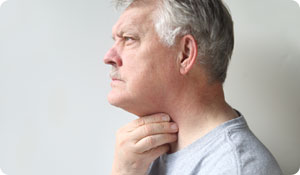
Gastroesophageal Reflux Disease (or GERD) is a fairly common ailment, affecting some 7 million people in the U.S., according to the U.S. Department of Health and Human Services. More than 50 percent of those afflicted with GERD are between the ages of 45 and 64, both male and female.
GERD occurs when—for reasons that are still unclear—the lower esophageal sphincter (LES) muscle does not close properly during mealtimes and digestive juices (acid) and food from the stomach spill up into the esophagus. Sometimes the LES muscle opens spontaneously throughout the day, which can also contribute to GERD.
At one time or another almost everyone has experienced acid indigestion—that sour taste at the back of the mouth caused by acid that has refluxed. Refluxed stomach acid can also case heartburn, which feels like a burning sensation near the chest or throat though it has nothing to do with the heart. Persistent heartburn that occurs more than twice a week may be diagnosed as GERD but long-standing (five or more years), severe heartburn may be a sign of a more serious condition such as Barrett's Esophagus, a pre-cancerous disease.
Although heartburn is the most common symptom, GERD doesn't give everyone who suffers from it heartburn. Difficulty swallowing and regurgitation of gastric contents into the mouth are other symptoms. According to the National Digestive Diseases Information Clearing House, there are also pulmonary manifestations of GERD such as asthma, coughing, or intermittent wheezing (caused by regurgitated acid in the lungs), and vocal cord inflammation with hoarseness. Refluxed acid can also hurt your teeth since it's strong enough to dissolve tooth enamel.
Other less common symptoms that may be associated with GERD include:
- Belching
- Sudden excess of saliva
- Dysphagia, the sensation of food sticking in the esophagus
- Inflammation of the gums
- A persistent, sour taste
- Bad breath
Doctors usually suggest using over-the-counter antacids (Mylanta, Tums, etc.) as well as making lifestyle changes such as avoiding certain acid-reflux inducing foods (coffee, chocolate, citrus and tomato products, fatty and fried foods, etc.) and tight-fitting clothing, waiting at least three hours after eating before lying down, raising the head of your bed, and eating small, frequent meals throughout the day instead of large meals which may curb the impulse to overeat. (Overeating triggers heartburn in many people.)
If these changes don't improve your discomfort, your doctor may refer you to a gastroenterologist, a specialist in diseases of the stomach and intestines. The doctor may ask you to keep a food diary to help him evaluate food triggers for acid reflux. A two-week trial with a prescription medication that inhibits gastric acid production known as a proton-pump inhibitor (medications including Prilosec®, Prevacid®, Nexium®, etc.) may also be suggested.
Further testing may be warranted however if your symptoms don't improve as complications from untreated GERD can include painful conditions like esophageal ulcers, erosions, and narrowing of the esophagus. Barrett's esophagus has also been linked to cancer. One such test is a barium swallow radiograph. The test involves fasting and drinking a chalky-tasting barium solution before X-rays are taken which help the doctor spot ulcers and other abnormalities. An ultrasound of your GI tract is another way for health care providers to see problems.
In some cases, an endoscopy will be performed. Though it takes just minutes, this procedure is typically conducted in a hospital and the patient is put under light anesthesia which enables the doctor to slide a thin, flexible tube through your upper gastrointestinal tract. Thanks to a light and camera that are attached to the tube, the physician can closely inspect the lining of the GI tract and remove small samples for biopsy.
Certain conditions may require surgical intervention. The standard is the Nissen fundoplication procedure in which the upper part of the stomach is wrapped around the LES to strengthen the sphincter and prevent acid reflux. It is safe and effective for people of all ages, including infants.
Sources:
The National Institute for Health; National Digestive Diseases Information Clearing House
http://digestive.niddk.nih.gov/ddiseases/pubs/yrdd/
American Academy of Family Physicians
http://www.familydoctor.org
U.S. Department of Health and Human Services
http://www.aboutgerd.org/site/about-gerd/characteristics/





